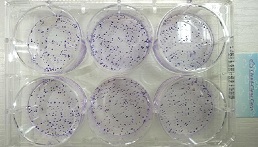Cell Colony Formation Assay Service
Instruction manual
First Edition (Revised on April, 2016)
【Service content】
Cell colony formation is cell inoculation survival rate, which means that the amount of adherent cells to survive and form clone. Adherent cells can not always proliferate and form clone, but cells that can form clone must be adherent cell with proliferation activity. Colony forming efficiency reflects cell population dependence and proliferation ability.
【Protocol& period】
Period: 2~3 weeks
Protocol:
(1) Take out each groups cells in logarithmic period, add 0.25% Trypsin to disperse them into individual cells, then suspend cells in 10% DMEM medium of fetal bovine serum.
(2) Dilute the cell suspension according to gradient concentration. Each groups cells with gradient density of 100 or 200 cells per dish were vaccinated into vessel or six plates with 37 degrees preheating solution. Gently rotate to make it evenly distributed, then put it into rsbiotech with the condition of 5%CO2, 37 degrees and saturated humidity for 2-3weeks.
(3) Keep observing, when cloning is visible, add 5ml 4% paraformaldehyde to fix cells for 15 minutes. Remove paraformaldehyde and add moderate Giemsa stain to dye about 10-30 minutes. Wash it and then dry in the air.
(4) Count the number of clones that are more than 10 cells under the microscope (low power mirror) and calculate colony forming efficiency.
Colony forming efficiency=(Number of cloning / Number of Inoculation cell)*100%
【Provided by customer】
1. Cell lines for assay or disposing (Our company can provide common used cell lines).
2. Drugs and experiment scheme for cell experiment.
【Service results】
1. Providing the experimental data and images.
2. Providing the test report.




